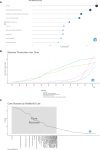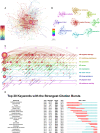Current trends and landscape of drug resistance in renal cell carcinoma: a bibliometric analysis
- PMID: 40389616
- PMCID: PMC12089581
- DOI: 10.1007/s12672-025-02594-0
Current trends and landscape of drug resistance in renal cell carcinoma: a bibliometric analysis
Abstract
Introduction: Renal cell carcinoma (RCC) is a common type of kidney cancer, and the prognosis for patients with advanced-stage disease remains poor. One major obstacle is the development of drug resistance, which severely limits the effectiveness of therapeutic interventions. This bibliometric study aims to provide a comprehensive overview of current research trends on drug resistance in RCC.
Methods: This study examines publications on drug resistance in RCC from 2000 to 2023, sourced from the Web of Science Core Collection (WoSCC). Detailed analyses were conducted to identify research hotspots, academic collaborations, and emerging trends. CiteSpace, SCImago Graphica, and VOSviewer were utilized to conduct these analyses comprehensively.
Results: This study analyzed a total of 2,804 publications from the WoSCC database. The number of annual publications showed a consistent upward trend, with an average annual growth rate of 8.12%. The United States had the highest number of publications, followed by China and Japan. The most productive institutions were the University of Texas System, Harvard University, and the National Institutes of Health (NIH). Alfred H. Schinkel emerged as the most prolific author, also having the highest H-index. The three most frequent research categories were oncology, pharmacology and pharmacy, and biochemistry and molecular biology. The evolution of research topics was assessed in 5-year intervals, revealing that recent themes such as ferroptosis and immunotherapy have gained increasing attention. Keyword analysis indicated a shift in research focus toward cell lipid metabolism, androgen receptor and specific molecular signatures.
Conclusion: This study offers the first comprehensive bibliometric analysis specifically focused on drug resistance in RCC. It identifies current research trends, highlights emerging hotspots, and provides insights into key contributors and ongoing challenges in the field. Our study provides a theoretical reference and guidance to guide future research efforts to address drug resistance in RCC more effectively.
Keywords: Bibliometric analysis; Drug resistance; Immunotherapy; Renal cell carcinoma; Targeted therapy; Visualization.
© 2025. The Author(s).
Conflict of interest statement
Declarations. Competing interests: The authors declare no competing interests.
Figures







Similar articles
-
Trends and hotspots in targeted therapy resistance research for renal cell carcinoma: a bibliometric and visualization analysis.Discov Oncol. 2025 Jun 11;16(1):1055. doi: 10.1007/s12672-025-02772-0. Discov Oncol. 2025. PMID: 40498158 Free PMC article.
-
Emerging research themes in ferroptosis research for non-small cell lung cancer: a bibliometric and visualized analysis.Front Immunol. 2025 May 16;16:1563108. doi: 10.3389/fimmu.2025.1563108. eCollection 2025. Front Immunol. 2025. PMID: 40453086 Free PMC article.
-
Decoding the research landscape of drug resistance and therapeutic approaches in head and neck cancer: a bibliometric analysis from 2000 to 2023.Front Pharmacol. 2024 Apr 5;15:1375110. doi: 10.3389/fphar.2024.1375110. eCollection 2024. Front Pharmacol. 2024. PMID: 38645557 Free PMC article.
-
Research hotspots and trends in healthcare workers' resilience: A bibliometric and visualized analysis.Heliyon. 2024 Jul 24;10(15):e35107. doi: 10.1016/j.heliyon.2024.e35107. eCollection 2024 Aug 15. Heliyon. 2024. PMID: 39170181 Free PMC article. Review.
-
Deciphering the Dynamics of EGFR-TKI Resistance in Lung Cancer: Insights from Bibliometric Analysis.Drug Des Devel Ther. 2024 Sep 26;18:4327-4343. doi: 10.2147/DDDT.S478910. eCollection 2024. Drug Des Devel Ther. 2024. PMID: 39350949 Free PMC article.
References
-
- Siegel RL, Miller KD, Wagle NS, Jemal A. Cancer statistics, 2023. CA Cancer J Clin. 2023;73:17–48. 10.3322/caac.21763. - PubMed
-
- Rizzo M, Calio A, Brunelli M, Pezzicoli G, Ganini C, Martignoni G, Camillo P. Clinico-pathological implications of the 2022 WHO renal cell carcinoma classification. Cancer Treat Rev. 2023;116:102558. 10.1016/j.ctrv.2023.102558. - PubMed
-
- Van Poppel H, Becker F, Cadeddu JA, Gill IS, Janetschek G, Jewett MA, Laguna MP, Marberger M, Montorsi F, Polascik TJ, Ukimura O, Zhu G. Treatment of localised renal cell carcinoma. Eur Urol. 2011;60:662–72. 10.1016/j.eururo.2011.06.040. - PubMed
-
- Diamond E, Molina AM, Carbonaro M, Akhtar NH, Giannakakou P, Tagawa ST, Nanus DM. Cytotoxic chemotherapy in the treatment of advanced renal cell carcinoma in the era of targeted therapy. Crit Rev Oncol Hematol. 2015;96:518–26. 10.1016/j.critrevonc.2015.08.007. - PubMed
Grants and funding
LinkOut - more resources
Full Text Sources
